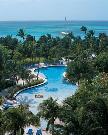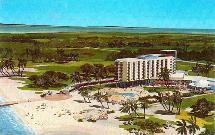 Palm Beach – The Radisson Aruba Resort Casino & Spa will be marking its 50th anniversary this summer. The resort is currently gearing up for the celebration which will include a formal cocktail party, on July 17th, a coffee-table book publications, a fund raising gala charity event, retro culinary experiences and the introduction of a special bulletin board on the resort website where colleagues and guests may post their pictures and anecdotes, from the past five decades. ( http://radisson-aruba.travelscreamforum.com/forumHome.aspx )
Palm Beach – The Radisson Aruba Resort Casino & Spa will be marking its 50th anniversary this summer. The resort is currently gearing up for the celebration which will include a formal cocktail party, on July 17th, a coffee-table book publications, a fund raising gala charity event, retro culinary experiences and the introduction of a special bulletin board on the resort website where colleagues and guests may post their pictures and anecdotes, from the past five decades. ( http://radisson-aruba.travelscreamforum.com/forumHome.aspx )
The Aruba’s Tourism Authority and the Aruba Hotel & Tourism Association will also be involved in the celebration since the Radisson anniversary also coincides with the commemoration of 50 year of hospitality on the island.
 A not-so-brief lesson in history, thank you: www.historiadiaruba.aw for research information:
A not-so-brief lesson in history, thank you: www.historiadiaruba.aw for research information:
Aruba’s first tourist hotel was the Coral Strand on the outskirts of Oranjestad, on the road to the airport. It opened in December 1943 and still operates today as the quaint and friendly Talk of the Town Hotel.
The second tourist hotel was Hotel Scala which opened in downtown Oranjestad, in March 1949. As a result of these initial efforts to promote the island as a vacation destination and encourage the creation of lodging facilities, Aruba’s tourism registered a record number of 980 visitors in 1950.
In 1953, the Aruba Tourism Bureau became a government agency and embarked on its life-long mission to create demand for the island. Aruba counted at that time just 100 hotel beds, 42 at the Coral Strand, 22 at Scala and 36 in the recently opened Hotel Marchena.
The importance of the development of beachfront resorts was recognized in the early 50s, inspired by the success of Miami Beach. In 1953, an official contest was held for the best design of a tourist hotel on pristine, magnificent Palm Beach, here. The winning plan for the “Basiroeti” was to be financed by the government, yet in encountered many hurdles and took until December 1954 to actually get off the ground. (The Basi Ruti Hotel was finally finished in February 1957 as a low rise cluster of bungalows sprawled over the sugar sand of virgin Palm Beach, where the Playa Linda Beach Resort stands today. In 1965, Dutch Princess Beatrix stayed at Basi Ruti during her visit to the island.)
Much was accomplished in 1954. The year marked the debut of the first mega promotional campaign for the island in the USA. Flyers were distributed among New York travel agencies and left at the KLM, Royal Dutch Airline ticket offices.
The ambitious campaign worked, and the sudden influx of visitors to the island delivered a new set of problems, as a scarcity of taxi cabs was reported and complaints regarding the hotel rates and airline fares were registered, as they were considered too high!
Aruba also arrived on the cruise ship scene around that time, when in February of 1955 “Tradewinds” tied up in the Oranjestad harbor. Local girls in festive frocks welcomed day-trippers coming off the ship and guided them though the streets of Oranjestad. The entire island came out to glare at the visitors and the ensuing gridlock caused a major traffic jam downtown. Ships operated by the Grace Line later became frequent visitors of the port.
 In 1956, the motivated island government approved plans for the building of a luxury tourist hotel on Palm Beach, which was to be called the Aruba Caribbean Hotel. Two local visionaries Juan Enrique Irausquin – the man who inspired the naming of our boulevard and Oscar Henriquez – who is still with us enjoying frequent travel and his flower garden - wrote a lengthy report filled with recommendations regarding the construction of this hotel. They gathered information and inspiration, as they traveled to Miami and Puerto Rico, and decided on an appropriate model for Aruba’s budding tourism trade. They both concluded that Aruba’s beaches are the best, and that the island could aspired higher, attracting ‘better’ clients seeking luxury, not economy.
In 1956, the motivated island government approved plans for the building of a luxury tourist hotel on Palm Beach, which was to be called the Aruba Caribbean Hotel. Two local visionaries Juan Enrique Irausquin – the man who inspired the naming of our boulevard and Oscar Henriquez – who is still with us enjoying frequent travel and his flower garden - wrote a lengthy report filled with recommendations regarding the construction of this hotel. They gathered information and inspiration, as they traveled to Miami and Puerto Rico, and decided on an appropriate model for Aruba’s budding tourism trade. They both concluded that Aruba’s beaches are the best, and that the island could aspired higher, attracting ‘better’ clients seeking luxury, not economy.
Juancho Irausquin, who was a politician from the ruling PPA party, is to this day regarded the mastermind behind Aruba’s tourism boom. As a result of his relentless push, a giant desalinization plant was built marking the availability of water, pitifully scarce until then. The construction of the road from Oranjestad to Palm Beach was also initialized making commute possible. In 1958, Aruba’s visitors traveled on a super-highway running from the airport to the end of the beach with traffic signs and secondary roads leading to tourist attractions such as the Casibari Rock Formation and the now crumbled Natural Bridge. Oranjestad’s main street was cleaned up, reportedly, two bars of ill-repute were ordered to set up shop elsewhere. During the Christmas season of 1958, all rooms on the island were occupied. Aruba was well on its way to becoming a brand, even before branding was invented
In their great wisdom, Irasquin and Henriquez insisted on a celebrity architect to design their new dream resort, and the designs for the building by award-winning, iconic American architect Morris Lapidus were approved. Lapidus was the creator of curvy, flamboyant Neo-baroque modern hotels, the genius who built the Fontainebleau Hotel and famed Eden Rock on Miami Beach. Legends have him scouring the beach here and studying the direction of the wind, until he was satisfied that he found just the perfect spot, he personally surveyed the grounds and initiated the clearing of what is today the Radisson Aruba Resort Casino & Spa.
In honor of the upcoming project Aruba’s first finance and management corporation was registered, Aruven, with two major shareholders, the Aruban and Venezuelan governments. In the summer of 1959 the official grand opening of the Aruba Caribbean Hotel took place – yes, 50 years ago - it was the first luxury resort of Aruba, boasting 120 rooms. The hotel provided 160 jobs, 120 of which were locals. The balance of the people working for the Carib were American managers, hired to run the glitzy, swanky casino.
In the 50s in general the Caribbean tickled the imagination of the American rich and famous. There was a growing interest in the Caribbean lifestyle and in 1957 a government report stated that the islands became America’s favorite playground. The sudden boost of popularity was mostly due to the hype surrounding calypso music and the myth created around sensational singer Harry Belafonte.
The chic American vacationers coming to the Carib to frolic in the waves – water skiing was also BIG - acquired a glowing tan, went out to the Klompen (famed Dutch clogs) Supper Club to listen to popular singers and entertainers, including Liberace, and check out each other over wedge salads and Beef Wellingtons. During the day they enjoyed some duty-free shopping, and the drinking of rum. Harry Belafonte, Elizabeth Taylor and Eddie Fischer were some of the regulars at the ‘Grand Dame,’ as the Aruba Caribbean Hotel, now the Radisson Aruba Resort Casino & Spa came to be called.
Aruba’s promotion as a tourism destination later invaded movie-theaters as a 1958 promotional film produced by KLM firmly established the island as a major player in the arena, a role which it has played for the past 50 years.
Naturally, none of this constant reinvention and tweaking, and adjustment would have been possible without the ingenious, sweet, hospitable, well-educate and good natured people of this island. Taking the industry in just 50 years from 100 to 8000 rooms, while maintaining a great tourist product and a good quality of life for locals took innate intelligence and the sure-footed persistence of people who know where they came from – from all over, and know where they are going to – into a bright, promising albeit at times bumpy future.
Pictured here how it all started, the original design, and the Radisson Aruba Resort Casino & Spa celebration logo.